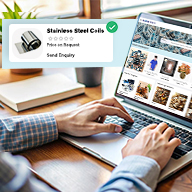5 proven strategies to boost your e-commerce sales

Ecommerce
322 week ago — 14 min read
In our previous article we solved the dilemma surrounding whether or not you should start your own e-commerce store. Now that you know why having an e-commerce store can benefit your business, it is time to address yet another important aspect of successful e-commerce marketing: how can you reach out to the right customers? Whether you are just starting out with online sales or already own an e-commerce store, having the right customers can steer your ship in the right direction without having to worry much about the rough winds, which in this case might mean stiff competition from other players in the market, shopping cart abandonment (which we shall discuss later in the article), generating targeted sales and so on.
In this article you will learn:
- To identify target customers on the basis of demography, interest etc
- How to be digitally social: Leverage Facebook, Instagram and other social media platforms to reach out customers in no time
- How you can hire online SEO agencies for organic sale (long term)
- How to use advertising for instant sale: Google Adwords, Google shopping, Facebook ads, Instagram ads
- How to set a strategy for cart abandonment: Coupons, cash backs and discounts
According to Statista, an estimated 1.8 billion people worldwide purchase goods online in 2018. During the same year, global e-retail sales amounted to 2.8 trillion U.S. dollars and projections show a growth of up to 4.8 trillion U.S. dollars by 2021.This clearly shows that a large number of customers are looking to shop from the comfort of their homes. You only need to bait the right fishes and bam! You have a successful e-commerce store!
Here are five proven factors that will help you be found in the market (you can thank us later!)
1. Determine your unique target audience
Finding the target audience for your online store is an important business level task. Whenever you are making a product, the biggest mistake you can make is to assume that your product is for everyone. To prevent yourself from shooting without an aim, you need to target a specific audience. While a decent content strategy and SEO tools will help garner 1000 instant hits right away but only 50 or 100 out of them would be relevant to your business.

You need to direct those 50 or 100 to your e-commerce store and you can do that by:
- Knowing your audience - Since you won’t get to interact with your customers physically as in a brick and mortar store, you need to understand their online behaviour. Suppose you own an active wear store, it is important that you understand the lifestyle of people who love traveling, their motivation to travel, where they consume information, how much they spend on travel, their influencers, etc.
- Imagining your potential customer – You can start making individual profiles of all the customers visiting your e-store. This way you will learn more about their behaviour.
- Customer segmentation – Now that you have their profiles, divide them on the basis of demographical information (name, address, age group, user behaviour).
- Surveys and feedbacks – You can conduct short surveys to analyse if customers like your products or if there is something you may need to change.
- Get to know your promoters – A promoter is someone (can be an individual firm, a group of persons or a company) who conceives the idea of a business and completes the various formalities necessary for starting a company. Promoters will help promote your business. Once you have determined your target audience, invest some money in looking for good promoters who can take your business to the next level.
- Understanding your competitors – This practice is one of the ‘e-commerce best practices’ to understand your competitors in the market. Playing customer for a day on your competitor's store can also teach you a lot about them and your product.
- Align marketing strategies with your customers – Try to figure out what works best for your customers. Change strategies if required. They flock your store before the holidays, bring out your best products then. Is there a slack in sales in February and March, may be it time to do a sale?
2. Be digitally social
By asking you to be social we aren’t saying you should transform into a social ninja but interacting with your customers across social media platforms will hugely benefit your sales. No wonder that in the recent times, social media has become an indispensable tool for product marketing and growth. People on an average spend about 2.5 hours a day browsing the internet - most of which is on social media channels.

But how can you engage your customers using social media? The answer is ‘by being digitally social’. Social media marketing helps connect with individuals on social media platforms but not engage, to engage effectively, a brand has to be active and responsive on social platforms. Let’s find out how:
- Engaging your customers – It is not about always the number of likes and shares that you get on your Facebook post or the number of followers on your Twitter, it is about humanely interacting with your customers to keep them hooked to your content. Try to be as informal as possible. Make your customers feel that it is a real person they are interacting with and not an automated system. Post pictures of your products and office events, participate in discussions and organise surveys. You may even link every social media post to your e-store for quick and easy conversions. The point is to engage with your customers to gain their trust and interest.
- Following customers back - Follow your customers to know which pages are they liking and hanging out on. In case of business professionals, try following up with customers on LinkedIn. Reply to the messages they send you and keep the conversation flowing.
- Offering your customers value deals – ‘I don’t want a good deal, said no one ever!’ Okay, we may have tweaked the line a little (‘wink’ ‘wink’), but you get the point we are trying to make here, right? Why do you think your customers are following you on social media? Liking your products or your brand is not just the reason. You can have a generous amount of followers but your conversion rates may fall. Offer your customers good deals, discount coupons, great prizes to be won on contests and special occasional offers. This will help improve your e-store’s conversion rates.
- Integrating social media icons on your website – This is a great way to redirect traffic to your social media pages. Make the user experience smoother by enabling them to share content of your e-store on social media. You can integrate your e-store with your company’s social media account for that. You can also integrate a blog on your website and post interesting articles for your customers.
- Leveraging the power of videos – This is one of the most effective ways to attract customers to your website. Invest in high quality videos or YouTube videos. Since Google also indexes the videos on your search results, you can drive solid traffic to your website.
3. Start advertising for instant sales
Now that you know how social media can boost your e-commerce sales, let’s move the needle to online advertising.

While you might be an expert on traditional ways of marketing using print ads, billboards and flyers, it’s time to understand the power of online marketing. You ask why? We say here’s why:
- Cost effective - Mostly small businesses are on a budget and online advertising saves you a great deal of money as they are much cheaper than traditional methods.
- Flexibility of reaching out to your customers – You can target your customers sitting in the remotest corners of the world using online advertising. This increases your brand awareness. Online Advertising also helps a business gain its initial customers and allows it to build a customer base, which is essentially needed by every online business
- Get measurable results and promote targeted market – Get instant gratification for the efforts you have put up for your e-commerce store. Unlike traditional ads, you can actually see who are viewing your ads and then you can promote specific messages and offers to that targeted group. Isn’t that so efficient?
4. Generate organic sales
Now you have an e-commerce store, you have successfully set up your social media platform and tried all online advertising methods and have great customers. But what if your website isn’t searchable on Google? This is nothing less than a nightmare right? Worry not because you have Search Engine Optimisation (SEO) to your rescue.

Following are some ways you can enhance the visibility of your e-store on Google:
- Plan your content – Before you go about publishing content on your website, optimise it with the right keywords. Keywords are nothing but the words or phrases that a customer searches for while looking for anything online. Try to use long tail keywords (more than 1-2 words). You can use online keyword planner tools like Google keyword planner, Wordstream etc.
- Study your competitors – Again a very important aspect of successful e-commerce sale. Know what your competitors are doing. Identify the top competitors in the market and the keywords they are using to rank well.
- Discard duplicate content – This is the easiest way to loose ranking and drop low in searches. Google doesn’t take duplicate content. If you want to use content from a different site, the best way is to link to that site. Try generating maximum genuine content.
- Use URLs that are SEO friendly – Keep your URLs clean and optimised. URLs are the address of a unique page on your website that directs the online users to your page.
- Optimise your content for mobile – More and more people are switching to their mobile phones to browse the internet and use social media or shop. Use it to your advantage by making your e-store mobile friendly.
- Create a great landing page – The landing page is where all the traffic from search engines, social and email marketing land. Your landing page should be a treat to the eyes and make customers want to stay there longer and explore.
- Share good content consistently – Google is always on the hunt for new content. Make sure that you update and generate fresh content on a regular basis.
- Follow SEO trends – SEO is an ever changing aspect. Check out different sites and sign up for SEO newsletters to keep with changing trends.
These easy Do-It-Yourself (DIY) can be followed to scale your online business but, as the head of a small business, you might not have the time or the necessary knowledge to invest in SEO which is natural. In such case, you might consider the idea of hiring an external SEO agency.
5. Setting strategy for cart abandonment
Last but not the least, the cart abandonment phenomenon that is highly common for all e-commerce stores. Customers add items to their cart proceed to check out and then drop off the idea and leave your site.

The reasons can be:
- Cost of shipping
- Cost of order became expensive while checkout
- Hassle of return/no return policy
- Lack of payment options
- Security issues
So, what can you do to solve this?
- Provide free shipping – Customers get annoyed to see additional charges levied on their original cart value. This is one of the most prominent reasons of cart abandonment. Offer them free shipping. It can be nationwide free shipping, on some min cart value or free shipping for first time buyers. You can play with your free shipping offers and mention it at the beginning so they stay put on your site and end up purchasing your products.
- Make your checkout process clean – having a confusing checkout process can easily lead to a loss of interest in your clients. Have clear call to action and explain why each step needs to be filled out or verified.
- Have coupon options – Before checkout you can have an additional tab asking them to ‘apply coupon code’ from the list of coupons made applicable. You can also auto apply coupons on products which will attract more shoppers.
- Include live chat option – To provide a sense of security to your customers, you can integrate a live chat bot where a sales representative can guide a customer and solve their queries at hand.
- Customer reviews- People believe what they see and hear. Customer ratings are a great way to increase sales. Inject customer added information like reviews, testimonials and ratings to improve your website and direct sales.
Linker.store makes all the above processes much easier, so why wait further? Head over to the website and create your store now!
Also let us know in the comments section below if you liked this article and is there anything you would like to know about reaching out to the right customers.
Related articles
Posted by
GlobalLinker StaffWe are a team of experienced industry professionals committed to sharing our knowledge and skills with small & medium enterprises.
Network with SMEs mentioned in this article
View GlobalLinker 's profile
Most read this week
Trending
Ecommerce 16 week ago














Comments (1)
Share this content
Please login or Register to join the discussion